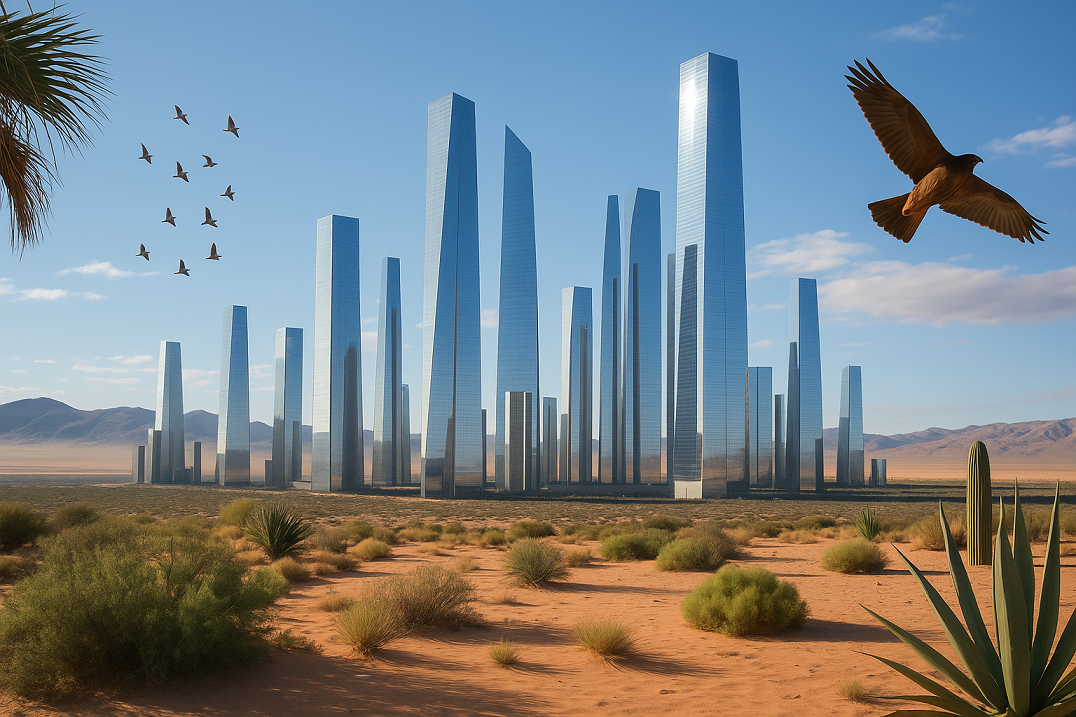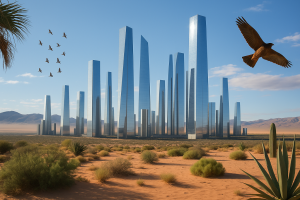Saudi Arabia’s NEOM project, a futuristic $500 billion megacity, has captured global attention with its ambitious “The Line”—a 105-mile-long, 1,640-foot-tall mirrored urban sprawl cutting through the desert. While proponents hail it as a revolutionary leap in sustainable urban living, environmentalists warn of catastrophic consequences for migratory birds traversing this critical flight path.
With construction underway, concerns mount over mass bird fatalities, habitat destruction, and the broader ecological impact of erecting a massive mirrored barrier in one of the world’s most vital avian migration corridors. This article delves into the environmental risks, construction challenges, and ethical dilemmas surrounding The Line, questioning whether Saudi Arabia’s vision of the future comes at too high a cost for nature.
The Line: A Futuristic Dream or an Ecological Nightmare?
What Is The Line?
Part of Saudi Arabia’s Vision 2030 initiative, The Line is a proposed 170-kilometer (105-mile) linear city designed to house 9 million people in a zero-carbon, car-free environment. The city’s most striking feature is its mirrored exterior, intended to blend with the desert landscape while harnessing solar energy.
Key features include:
✅ Zero-emission urban design
✅ AI-driven infrastructure
✅ Underground high-speed transport
✅ Vertical city layout to minimize land use
Despite its innovative appeal, The Line’s mirrored façade poses a deadly threat to millions of migratory birds that rely on this region as a crucial stopover.
The Deadly Impact on Migratory Birds
Why Is The Line a Death Trap for Birds?
Every year, billions of birds traverse the Red Sea Flyway, a major migration route between Africa and Eurasia. Saudi Arabia’s location makes it a critical refueling stop for species like:
-
Honey Buzzards
-
Steppe Eagles
-
European Bee-eaters
-
White Storks
The Line’s massive mirrored walls create an invisible barrier, causing fatal collisions as birds mistake reflections for open sky. Studies on glass and mirror collisions estimate that up to 1 billion birds die annually from building impacts in the U.S. alone. The Line’s unprecedented scale could dramatically increase this toll.
Scientific Warnings & Environmental Backlash
-
BirdLife International has flagged NEOM as a high-risk zone for avian fatalities.
-
The Reflective Surface Hazard Index (RSHI) suggests mirrored buildings in migration paths increase collision risks by 300%.
-
Saudi environmental groups report that no comprehensive impact assessment has been made public.
Despite these concerns, NEOM’s developers have not announced mitigation measures, such as bird-safe glass or patterned facades to reduce reflections.
Construction Delays & Scaling Back of Ambitions
Is The Line Falling Short of Its Goals?
Originally slated for completion by 2030, The Line has faced significant setbacks:
-
Revised population estimates: Only 300,000 residents expected by 2030 (down from 9 million).
-
Construction delays: Only 2.4 km of excavation completed so far.
-
Financial challenges: Rising costs and skepticism from investors.
Why the Slow Progress?
-
Engineering hurdles: Building a 500-meter-tall mirrored structure in a desert presents unprecedented challenges.
-
Labor shortages: Reports of difficulty attracting skilled workers to remote sites.
-
Environmental lawsuits: Potential legal battles over habitat destruction.
Can The Line Be Eco-Friendly? Possible Solutions
How to Prevent a Bird Massacre
If Saudi Arabia proceeds with The Line, urgent mitigation strategies must include:
-
Bird-Safe Glass: Using UV-patterned or fritted glass to make walls visible to birds.
-
External Netting & Screens: Installing protective barriers to deflect birds.
-
Lights-Out Policies: Reducing nighttime illumination to avoid disorienting migrants.
-
AI Monitoring Systems: Deploying radar and cameras to detect flocks and adjust lighting.
Learning From Global Precedents
-
New York’s “Lights Out” Program: Reduced bird collisions by 60%.
-
Toronto’s Bird-Friendly Guidelines: Mandates patterned glass in high-risk zones.
-
Jeddah Tower’s Adjustments: Saudi’s other mega-project incorporated avian safety measures.
Ethical Dilemma: Progress vs. Nature
Should Mega-Projects Like The Line Proceed?
The Line represents a clash between innovation and conservation:
✔ Pros:
-
Pioneering sustainable urban design
-
Reducing carbon footprint with car-free living
-
Boosting Saudi Arabia’s post-oil economy
❌ Cons:
-
Potential mass extinction of migratory birds
-
Desert ecosystem disruption
-
Lack of transparency in environmental studies
The Bigger Question: At What Cost?
As the world moves toward green urbanization, projects like The Line must balance ambition with responsibility. If millions of birds perish annually, can this truly be called “sustainable”?
Conclusion: A Call for Responsible Development
Saudi Arabia’s The Line is a test case for futuristic cities, but its environmental risks cannot be ignored. Without urgent bird-safe modifications, this 105-mile mirror wall could become one of the deadliest structures for wildlife in history.
The choice is clear: Innovation must not come at the expense of nature. If NEOM’s developers prioritize ecological safeguards, The Line could set a new standard for sustainable cities. If not, it risks becoming a monument to human hubris—and a graveyard for birds.
What Do You Think?
Should Saudi Arabia halt construction until bird-safe measures are in place? Or is the economic and technological payoff worth the ecological cost? Share your thoughts in the comments!


